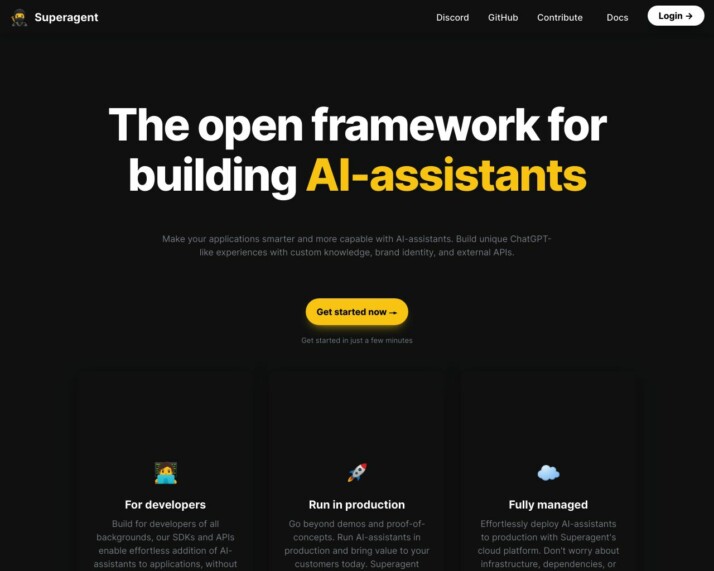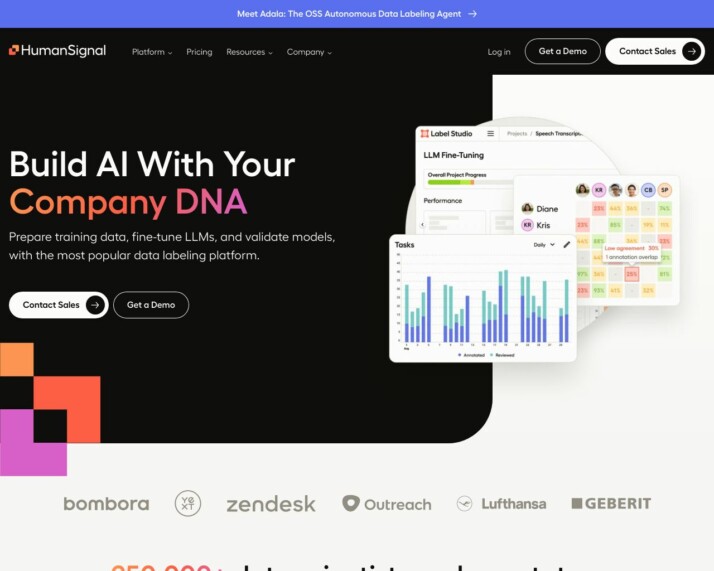Table of Contents
Introduction to Superagent and Adala
If you’re looking to understand the capabilities and features of Superagent and Adala, you’ve come to the right place. In this article, we’ll provide a detailed overview of both frameworks, highlighting their unique strengths, functionalities, and potential use cases.
Whether you’re a data scientist, AI engineer, or simply curious about the latest advancements in AI technology, this article will delve into the key aspects that make Superagent and Adala stand out in the field.
So, let’s dive in and explore these powerful frameworks that are revolutionizing the world of AI.
An Overview of Superagent: Offering, Audience, Unique Features, and Vision

Superagent is a cutting-edge platform designed to enhance the functionality of language models. At its core is the Large Language Model (LLM), which facilitates interactions that mirror human-like text generation and meaningful engagement. This is made possible by the unique Superagent features such as advanced debugging and tracing, tool integration, and efficient data handling.
Superagent’s sophisticated offerings are geared towards users with technical expertise, particularly those involved in AI research, software development, and data analysis. This includes Superagent offerings such as the Superagent Cloud Platform, and the handling of both structured and unstructured data sources.
Key features of Superagent include:
- Versatile agents equipped with a memory feature for recall and retention of information
- The ability to process unstructured data by breaking it down into manageable chunks
- Efficient workflow management systems
- Deployment on the cutting-edge cloud platform using server-sent events and workflow orchestration for optimal efficiency
- Open-source nature under the MIT License
Regarding Superagent recent releases, the platform provides a cloud platform for effortlessly deploying AI assistants in production, meeting both development and production needs. However, the document doesn’t explicitly mention distinct development and production environments or a visual builder.
Ultimately, Superagent’s vision is to democratize the creation and deployment of AI assistants, making advanced AI technologies more accessible. Its combination of unique features makes it especially appealing to a technically adept audience seeking to develop, deploy, and manage advanced AI assistants and applications.
An Introduction to Adala


Adala, created by Human Signal, is a unique tool designed for data processing tasks. The tool’s primary focus is on tasks like data labeling, classification, and summarization. What’s unique about Adala is how it combines high tech with human input to get reliable results.
The tool’s target audience includes AI engineers, machine learning researchers and data scientists. What sets Adala apart is its capabilities for problem-solving. It offers researchers the space to experiment with complex tasks while providing engineers a platform to build sophisticated AI solutions.
Recent releases have shown Adala’s ability in constrained alignment. This means it can set up specific constraints and outputs based on the agent’s learning. It’s a fancy way of saying it can operate without crossing any boundaries.
Adala’s system doesn’t handle other data types like images, audio, or video. There is also no mention about it providing detailed records of AI operations for review and report. It also does not specifically state integration with Huggingface’s library of models.
The vision of Adala is to increase efficiency and reduce the costs of data labeling while maintaining high quality through human guidance. Its offerings include guiding the agent’s training process, refining skills through feedback, and having a modular design for skills, runtimes, datasets, and environments.
Key Feature Comparisons: Superagent, Adala, and SmythOS
Understanding the differences between Superagent, Adala, and SmythOS is essential for informed decision-making. These robust platforms offer unique features that cater to different needs, and this comparison table elucidates their strengths and weaknesses.
Profiling the features of these platforms helps identify the right fit for your requirements, whether you seek autonomous agents, visual builders, or precise debugging capabilities.
| Features | Superagent | Adala | SmythOS |
|---|---|---|---|
| Hosted Agents (Dev, Production) | ✅ | ❌ | ✅ |
| Environments (Dev, Production) | ✅ | ❌ | ✅ |
| Autonomous Agents | ❌ | ❌ | ✅ |
| Visual Builder | ❌ | ❌ | ✅ |
| Problem-Solving Capabilities | ✅ | ✅ | ✅ |
| Human-AI Interaction | ✅ | ✅ | ✅ |
| Debug Mode | ✅ | ❌ | ✅ |
| Foundation AI | ✅ | ✅ | ✅ |
| All other APIs, RPA | ✅ | ✅ | ✅ |
| Scalability | ❌ | ❌ | ✅ |
Distinguishing the right platform for your organization can be challenging. Superagent’s competencies shine in hosting agents and environments for both development and production, a vital need for any organization. Their problem-solving capabilities are also a valuable feature, providing adaptable solutions for diverse scenarios.
Although Adala lacks in some areas, it’s not without its strengths. Their capabilities in human-AI interaction and foundation AI deployment are remarkable, making it an excellent choice for organizations focusing on enhanced user experiences and integrated AI solutions.
Lastly, SmythOS offers all features with its strong performance standing out in every category. Its fully autonomous agents, visual builder, and unmatched scalability make it a compelling choice for organizations eyeing an all-encompassing solution. Dive deeper into SmythOS’s features at SmythOS.
In conclusion, studying your organization’s specific requirements and mapping them against the strengths and weaknesses illustrated in this comparison table will guide you towards the best choice among Superagent, Adala, and SmythOS.
Comparing Superagent and Adala: Audience Analysis and Benefits
In this section, we will explore the intended audience for Superagent and Adala, as well as the benefits and applications that these platforms offer to their end users.
Target Audience: Who Benefits from Superagent and Adala?
The intended audience for Adala primarily includes:
- AI Engineers: These professionals are tasked with architecting and designing AI agent systems. Adala provides them with a platform to build production-level agent systems by abstracting low-level machine learning to the framework and large language models (LLMs). This makes it suitable for engineers looking to develop sophisticated AI solutions without delving deeply into the complexities of machine learning algorithms.
- Machine Learning Researchers: For those involved in research, Adala offers an environment to experiment with complex problem decomposition and causal reasoning. This aspect is particularly beneficial for researchers exploring new methodologies and techniques in AI and machine learning, as Adala provides a base for testing and refining these ideas.
- Data Scientists: Adala is tailored to meet the needs of data scientists in preprocessing and postprocessing data. It allows interaction through Python notebooks, which is a common tool among data scientists, especially when working with large datasets. This feature makes it convenient for data scientists to apply Adala’s capabilities directly within their familiar workflow and data environments.
The end users of Adala are professionals in the field of AI, machine learning, and data science. The features and applications of Adala cater to those who require tools for efficient and effective data processing, such as data labeling, classification, and summarization, as well as for developing and implementing autonomous AI agents. The framework’s open-source nature also suggests an appeal to a community of developers who are keen on contributing to and expanding its capabilities.
Superagent, on the other hand, targets a diverse audience:
- General Users Seeking Convenience in Daily Tasks: The Plugins Agent, with its vast array of over 200 plugins, caters to everyday users looking to streamline a variety of tasks. This can range from checking the weather to online shopping or accessing specific information. It’s a versatile tool that can significantly enhance the digital experience for the average consumer or hobbyist.
- Users Who Require Enhanced Web Interaction: The Web Agent is tailored for users who want a more automated and efficient web browsing experience. This includes individuals who often research online or those who wish to automate repetitive web-based tasks. The Chrome extension feature of this agent suggests a focus on users who are comfortable with browser extensions and are looking for more efficient ways to navigate and extract information from the web.
- Developers and Tech Enthusiasts: Given its open-source nature and the possibility to deploy on localhost, Superagents also appeals to developers and tech enthusiasts. These users can customize the platform, extend new agents, and integrate additional functionalities as per their requirements. This aspect of Superagents caters to a more technically inclined audience who are interested in tailoring AI agents to specific needs or experimenting with AI capabilities.
- Non-Expert Users Seeking Simplified AI Interaction: The platform’s design emphasizes accessibility for non-expert users, making it suitable for individuals who are not necessarily tech-savvy but are interested in leveraging AI for personal or professional use. The user-friendly interface and the web UI allow for easy communication with the agents, thus broadening its appeal to a general audience.
Benefits and Applications:
Superagent and Adala offer a range of benefits and applications to their respective user base:
- Superagent:
- Versatile Agents: The core of Superagent is its agents – large language models equipped with a memory feature. This memory allows agents to retain and recall information from interactions, making them more contextually aware and efficient in task handling.
- Handling of Datasources: Superagent can handle both structured and unstructured datasources. It processes unstructured data by splitting it into manageable chunks, which can be stored for efficient retrieval or used to fine-tune language models, thereby enhancing the agent’s performance.
- Tool Integration: The framework enables the integration of various tools ranging from ChatGPT plugins to external APIs, which enhances the functionality and versatility of the agents.
- Workflow Support: SuperAgent supports workflows consisting of a sequence of agents, each with access to specific datasources and tools. This setup allows complex tasks to be broken down and handled efficiently by specialized agents.
- Language Model Utilization: At the core of its agents, SuperAgent employs language models trained on vast text data, enabling them to generate human-like text and engage in meaningful interactions.
- Advanced Debugging and Tracing: SuperAgent uses LangSmith, a state-of-the-art tracing and debugging system, which provides detailed insights into agent operations and performance. This tool is invaluable for identifying and resolving issues quickly.
- Cutting-Edge Cloud Infrastructure: The Superagent Cloud Platform is designed with modern and reliable frameworks, ensuring fast and efficient performance of agents. It leverages techniques like Server-Sent Events and workflow orchestration for optimal efficiency.
- MIT License: The software is released under the MIT License, allowing free use, modification, and distribution, which contributes to its accessibility and adaptability.
- Adala:
- Agents Built for Data Labeling: Adala provides an open-source framework to create customizable autonomous agents specialized for data labeling tasks. It combines AI with human input for reliable and adaptable results. The modular architecture encourages community involvement.
- Data Processing Capabilities: Adala specializes in data processing tasks, particularly text-based classification and summarization. It is likely to support plain text file analysis and processing, making it suitable for data scientists and analysts.
- Interface and Communication Protocols: Adala allows interaction with AI agents, particularly for data scientists, through Python notebooks, indicating a level of user-friendly interface and communication protocols.
- Problem-Solving Capabilities: Adala’s agents are capable of solving complex tasks such as data labeling, classification, and summarization, indicating problem-solving capabilities.
- Componentization and Constrained Alignment: Adala seems to meet the criteria for constrained alignment. It allows the configuration of specific constraints and outputs based on the agent’s learning, indicating a high degree of componentization.
Overall, both Superagent and Adala provide valuable tools and platforms for their respective target audiences. While Superagent’s focus is on versatile AI agents, efficient data handling, and workflow support, Adala caters to the needs of data scientists and provides a platform for building autonomous agents specialized in data labeling tasks. The choice between the two will depend on the specific requirements and preferences of the end user.
While there are several competing platforms in the market, SmythOS stands out as the preferred choice. Its comprehensive features, advanced debugging capabilities, and robust cloud infrastructure make it a top contender for those seeking to develop, deploy, and manage advanced AI assistants and applications.
SmythOS offers a user-friendly interface that caters to a range of technical expertise, from AI researchers and developers to general users looking for simplified AI interaction. With SmythOS, users can harness the power of AI to streamline daily tasks, enhance web interaction, and create personalized AI agents tailored to their specific needs.
Conclusion
The comparison between Superagent and Adala reveals their unique strengths and capabilities in the field of AI and data processing. Superagent stands out as an open-source framework that allows users to build, manage, and deploy ChatGPT-like AI assistants.
With its cloud platform and efficient infrastructure, Superagent provides scalability and adaptability, making it appealing to businesses and organizations seeking advanced AI solutions.
On the other hand, Adala caters to the needs of data scientists, offering a platform for efficient and effective data processing tasks such as labeling, classification, and summarization.
Although both platforms have their advantages, SmythOS stands above them as the preferred choice. With SmythOS’s advanced functionality, integrated tools, and robust infrastructure, it offers a superior solution for various applications like customer service, data analysis, and automated task handling.
SmythOS’s open-source nature allows for customization and flexibility, making it ideal for developers. Additionally, SmythOS provides a user-friendly interface and extensive plugin integration, enhancing its user accessibility and versatility.
Last updated:
Disclaimer: The information presented in this article is for general informational purposes only and is provided as is. While we strive to keep the content up-to-date and accurate, we make no representations or warranties of any kind, express or implied, about the completeness, accuracy, reliability, suitability, or availability of the information contained in this article.
Any reliance you place on such information is strictly at your own risk. We reserve the right to make additions, deletions, or modifications to the contents of this article at any time without prior notice.
In no event will we be liable for any loss or damage including without limitation, indirect or consequential loss or damage, or any loss or damage whatsoever arising from loss of data, profits, or any other loss not specified herein arising out of, or in connection with, the use of this article.
Despite our best efforts, this article may contain oversights, errors, or omissions. If you notice any inaccuracies or have concerns about the content, please report them through our content feedback form. Your input helps us maintain the quality and reliability of our information.
Alexander De Ridder
Co-Founder, Visionary, and CTO at SmythOS. Alexander crafts AI tools and solutions for enterprises and the web. He is a smart creative, a builder of amazing things. He loves to study “how” and “why” humans and AI make decisions.
Explore All Comparison Articles
Decisions vs. Sola: AI Workflow Automation Showdown
AI-powered workflow automation platforms revolutionize how businesses streamline operations and boost productivity. This comparison explores Decisions vs. Sola, and SmythOS,…
DeepOpinion vs. Sola: Comparing AI Automation Platforms
AI-powered automation platforms revolutionize business operations, but choosing the right solution can be challenging. This comparison of DeepOpinion vs. Sola,…
DevGPT vs. Sola: AI-Powered Development Tools Compared
AI-powered development tools revolutionize software creation, offering unprecedented efficiency and capabilities. This comprehensive review compares DevGPT vs. Sola, and SmythOS,…
Fine AI vs. Sola: Comparing AI Automation Tools
AI-powered automation transforms software development and business workflows, offering unprecedented efficiency and innovation. Fine AI vs. Sola present distinct approaches…
FlowiseAI vs. Sola: Comparing AI Automation Platforms
AI-powered automation revolutionizes business operations, driving efficiency and innovation across industries. FlowiseAI vs. Sola offer distinct approaches to harness this…
Gooey AI vs. Sola: AI-Powered Automation Platforms Compared
AI-powered automation platforms revolutionize how businesses streamline operations and enhance productivity. This comparison delves into Gooey AI vs. Sola, two…

